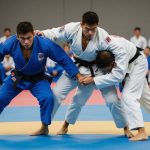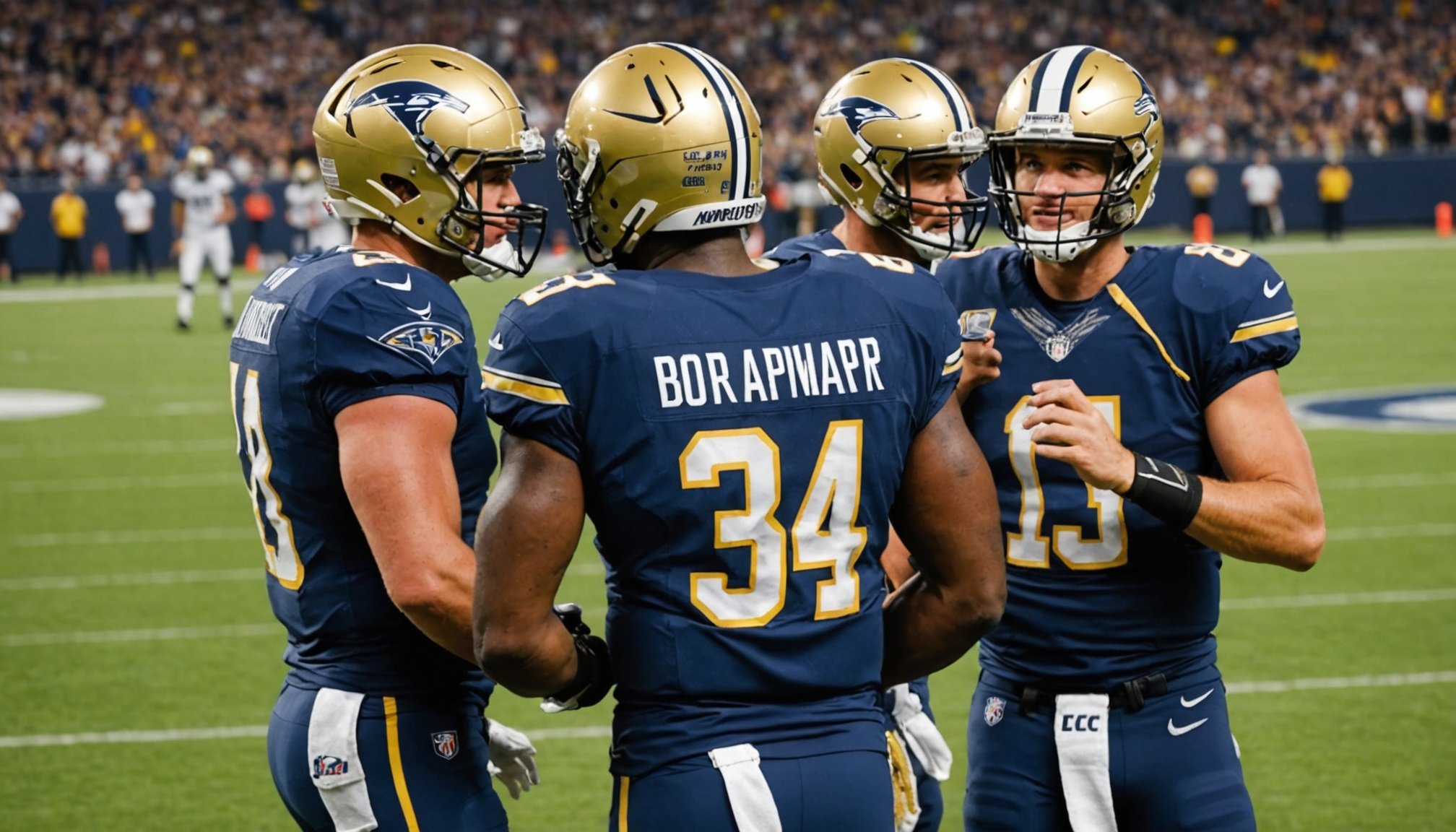Mastering On-Field Communication: Top Strategies for Football Players to Connect and Conquer
The Importance of On-Field Communication in Football
On-field communication is the backbone of any successful football team. It is the glue that holds the team together, ensuring that every player is on the same page and working towards a common goal. In the fast-paced and dynamic environment of a football match, clear and effective communication can be the difference between victory and defeat.
“Communication is key in football. When players communicate effectively, it enhances their ability to execute the game plan, make quick decisions, and respond to the opposing team’s strategies,” notes a seasoned football coach.
Also to read : Exploring the Influence of Fan Loyalty on Football Team Success and Strategies for Clubs to Amplify Support
Here are some reasons why on-field communication is crucial:
- Execution of the Game Plan: Clear communication helps players understand their roles and responsibilities within the team’s strategy. This ensures that every player knows what is expected of them and can execute their tasks efficiently.
- Decision Making: Quick and accurate communication allows players to make informed decisions on the field. Whether it’s calling out defensive assignments or signaling a change in formation, communication helps players react swiftly to changing situations.
- Team Cohesion: Communication fosters a sense of unity and teamwork. When players communicate effectively, they build trust and confidence in each other, leading to a more cohesive and formidable team.
Strategies for Effective On-Field Communication
Verbal Communication
Verbal communication is the most direct and immediate way to convey information on the field. Here are some strategies to enhance verbal communication:
Additional reading : Essential Psychological Strategies to Enhance Confidence in Struggling Football Players
- Clear and Concise Commands: Players should use clear, concise language to avoid confusion. For example, instead of shouting “Get back!” a player could say “Drop back to the defensive line!”
- Use of Standard Phrases: Teams can develop standard phrases for common situations. For instance, “Switch!” to indicate a need to swap defensive assignments.
- Active Listening: Players must listen attentively to instructions and feedback from teammates and coaches. This ensures that everyone is aligned and executing the game plan correctly.
Non-Verbal Communication
Non-verbal cues are equally important and can often convey messages more quickly than verbal commands.
- Hand Signals: Coaches and players can use hand signals to communicate tactics without alerting the opposing team. For example, a coach might use a specific hand gesture to signal a change in formation.
- Body Language: Players can use body language to communicate their intentions. For instance, a player might point to a teammate to indicate where they should move.
- Eye Contact: Maintaining eye contact can help players stay focused and ensure they are on the same page.
Training Sessions to Enhance Communication
Training sessions are crucial for developing and refining on-field communication skills. Here are some ways coaches can incorporate communication into their training:
Drills and Exercises
- Scrimmage Drills: Conduct scrimmages where players are required to communicate constantly. This can include calling out defensive assignments, signaling set pieces, and coordinating attacks.
- Small-Sided Games: Small-sided games (e.g., 3v3 or 4v4) can help players develop their communication skills in a more intense and focused environment.
- Role-Playing: Use role-playing exercises to practice different scenarios, such as free kicks or corner kicks, where communication is critical.
Feedback and Review
- Video Analysis: Review game footage to identify areas where communication could be improved. This helps players see the impact of their communication on the game.
- Post-Game Debriefs: Hold post-game debriefs where players and coaches discuss what went well and what could be improved in terms of communication.
- Player Feedback: Encourage players to provide feedback to each other. This fosters a culture of open communication and continuous improvement.
Learning Styles and Communication
Different players have different learning styles, and understanding these can help coaches tailor their communication strategies.
Visual Learners
- Use Visual Aids: Visual learners benefit from diagrams, videos, and other visual aids that illustrate the game plan and communication strategies.
- Demonstrations: Coaches can demonstrate tactics and communication techniques on the field to help visual learners understand better.
Auditory Learners
- Verbal Instructions: Auditory learners respond well to verbal instructions and feedback. Coaches should provide clear, detailed verbal explanations.
- Audio Recordings: Using audio recordings of game plans and communication strategies can help auditory learners review and understand the information better.
Kinesthetic Learners
- Hands-On Training: Kinesthetic learners learn best through hands-on training. Coaches should incorporate a lot of practical drills and exercises into their training sessions.
- Real-Game Scenarios: Simulating real-game scenarios during training helps kinesthetic learners understand how to apply communication skills in actual match situations.
Case Study: Premier League Teams
Premier League teams are known for their high level of on-field communication. Here’s a look at how some of these teams approach communication:
Manchester City
- Pre-Match Briefings: Manchester City is known for its detailed pre-match briefings where coaches and players discuss the game plan, opposing team strategies, and communication protocols.
- Mid-Game Adjustments: The team is adept at making mid-game adjustments, which are communicated quickly and effectively through a combination of verbal and non-verbal cues.
Liverpool
- Player Empowerment: Liverpool empowers its players to take ownership of communication on the field. Players are encouraged to communicate freely and make decisions based on the game situation.
- Set Piece Communication: Liverpool is particularly strong in set piece communication, using a combination of hand signals and verbal cues to coordinate their set pieces effectively.
Practical Insights and Actionable Advice
Here are some practical tips for football players and coaches to improve on-field communication:
For Players
- Stay Focused: Maintain concentration throughout the game to ensure you are always aware of the communication happening around you.
- Be Clear and Concise: When communicating, use clear and concise language to avoid confusion.
- Use Standard Phrases: Develop and use standard phrases for common situations to ensure everyone understands the message quickly.
For Coaches
- Develop a Communication Plan: Create a detailed communication plan that includes both verbal and non-verbal cues.
- Incorporate Communication into Training: Make communication a central part of your training sessions.
- Provide Feedback: Regularly provide feedback to players on their communication skills and suggest areas for improvement.
Table: Comparing Communication Strategies
| Strategy | Description | Benefits | Challenges |
|---|---|---|---|
| Verbal Communication | Using clear, concise language to convey messages. | Immediate and direct, helps in quick decision-making. | Can be misunderstood, may alert the opposing team. |
| Non-Verbal Communication | Using hand signals, body language, and eye contact. | Quick and discreet, reduces the risk of alerting the opposing team. | Can be misinterpreted, requires practice to be effective. |
| Training Drills | Incorporating communication into scrimmage drills and small-sided games. | Enhances teamwork and coordination, prepares players for game scenarios. | Requires careful planning and execution. |
| Feedback and Review | Using video analysis and post-game debriefs to improve communication. | Helps players understand their communication impact, identifies areas for improvement. | Time-consuming, requires commitment from players and coaches. |
| Learning Styles | Tailoring communication strategies to different learning styles. | Ensures that all players understand and apply communication skills effectively. | Requires understanding of individual learning styles, can be complex to implement. |
Mastering on-field communication is a critical component of success in football. By understanding the importance of communication, implementing effective strategies, and tailoring approaches to individual learning styles, teams can significantly enhance their performance.
As a football player or coach, remember that communication is not just about shouting instructions; it’s about creating a cohesive unit that works together seamlessly. With the right strategies and a commitment to continuous improvement, any team can conquer the challenges of the game and achieve success.
In the words of a renowned football coach, “Communication is the heart of football. When players communicate effectively, they become an unstoppable force on the field.”











